If you’re growing peppers, you want to get the most out of each plant. It can be exciting to see the very first flowers start forming on your plants. More flowers means more peppers, right?
Since we start our peppers indoors in the late spring, it is not unusual to see flower buds beginning to form in April or May. So that begs the question, should you remove flowers from your pepper plants? in this article, I’ll share our advice on pinching flower buds.
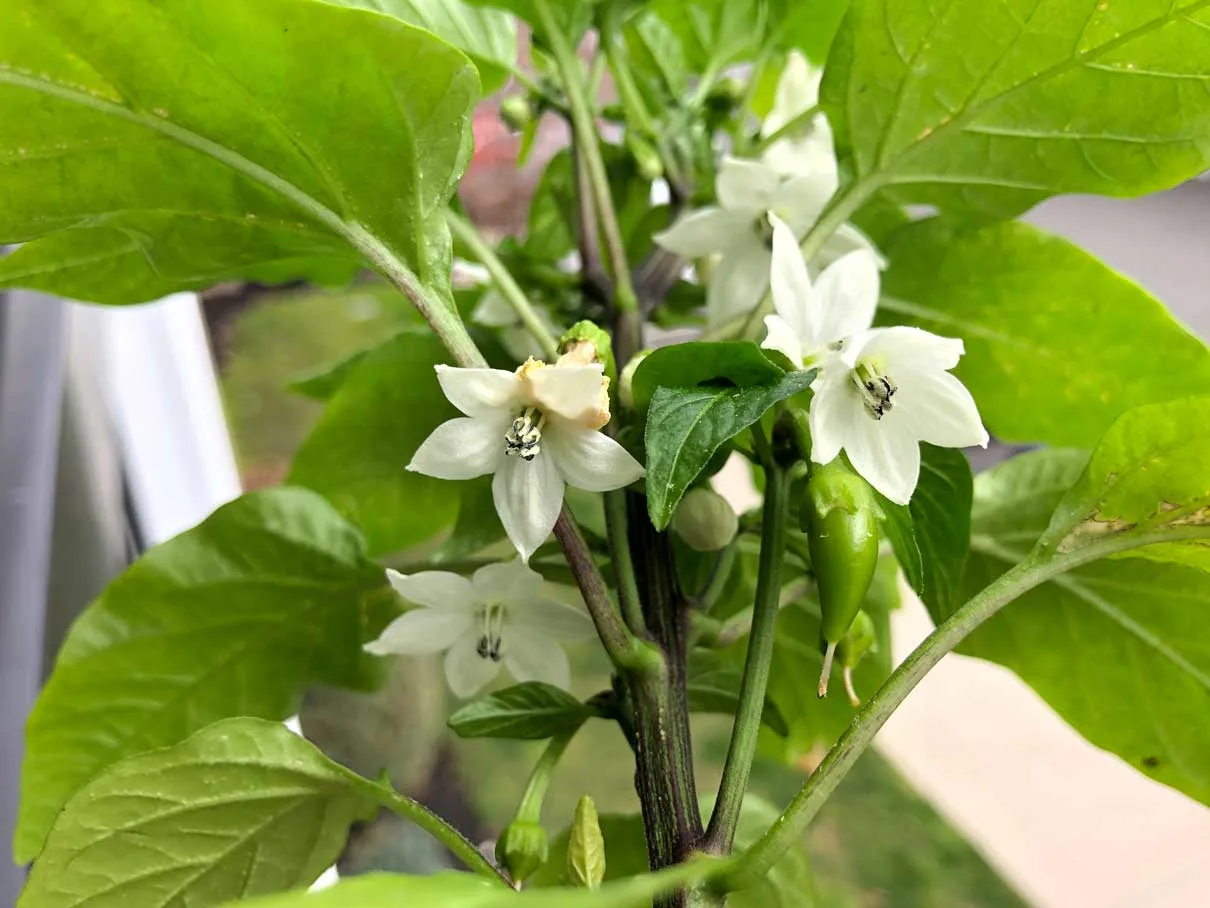
In this article:
- What are pepper flowers?
- Should you prune pepper flowers?
- How to pick pepper flowers
- When to stop picking pepper flowers
- Why are my pepper flowers falling off?
Should You Pick Pepper Flowers? (Video):
What Are Pepper Flowers?
If you are new to gardening and growing peppers, you may wonder what purpose the flowers serve. Before I had any experience growing, I wondered this myself.
Well, if you leave the flowers alone, they’ll transform into tiny peppers!
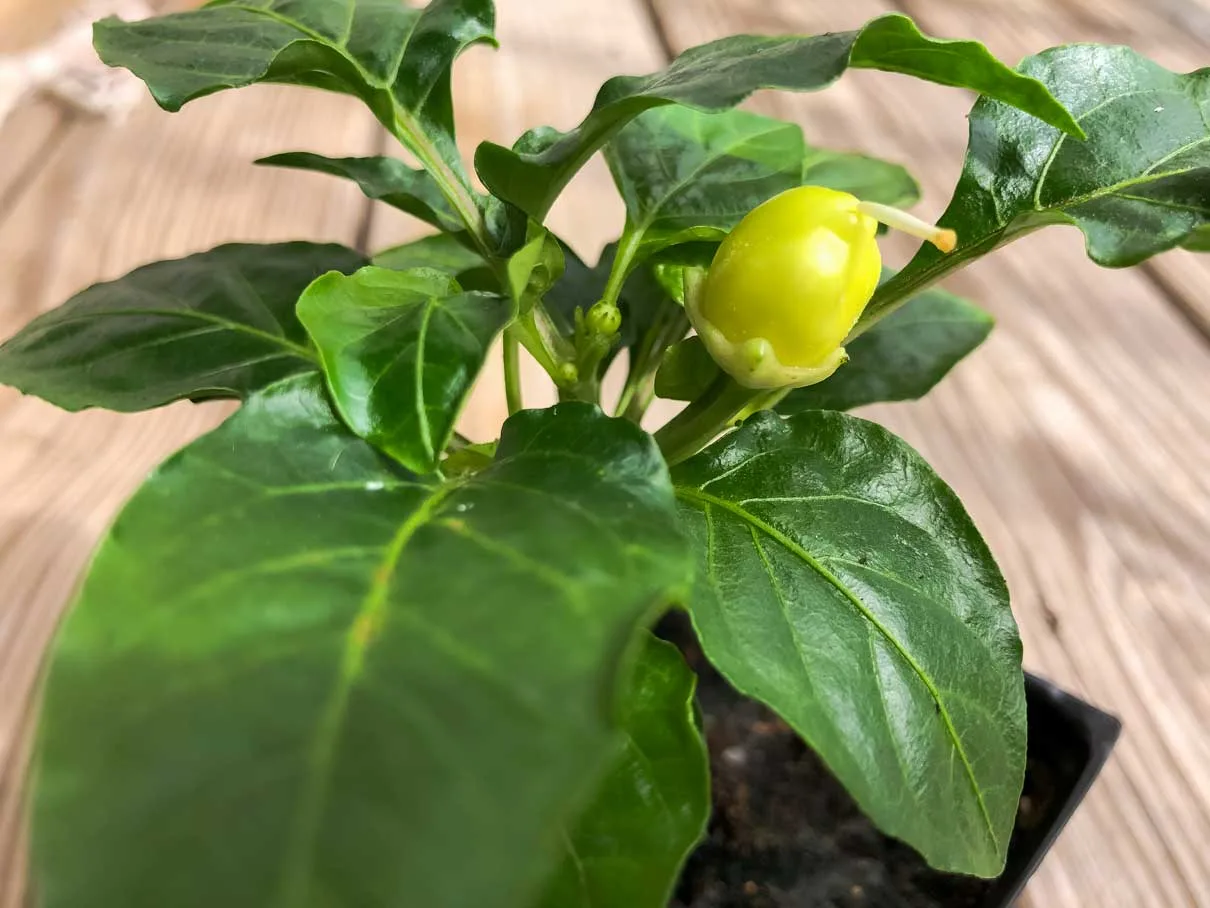
The flowers on a pepper plant will turn into the actual peppers. Essentially, the flowers attract insects to your pepper plants which pollinate the flowers. Bees, flies, and even the wind help to fertilize the flowers, and the peppers bear seeds.
Peppers self-pollinate, meaning that each flower contains both male and female reproductive parts. This means that you don’t have to worry about growing multiple plants side by side to get good harvests.
However, sometimes pepper plants can begin flowering too early. A number of factors can cause this, including small pot size, not enough fertilizer, or irregular temperatures.
Should I Pinch Off Early Pepper Flowers?
If you are waiting for the weather to warm up so that your plants can safely move outdoors, your plants may start producing flowers prematurely. This is a pepper plant’s natural response to limited soil space. If the plant doesn’t have enough soil to continue growing more roots, it will begin the next stage of growth, producing fruit.
During the transition outside, I recommend to prune early pepper flower buds off of the plant. Be sure to first allow the flowers to grow large enough so you don’t damage the young leaves when picking. Another option is to only pick flowers that begin forming fruits, and leave the rest alone.
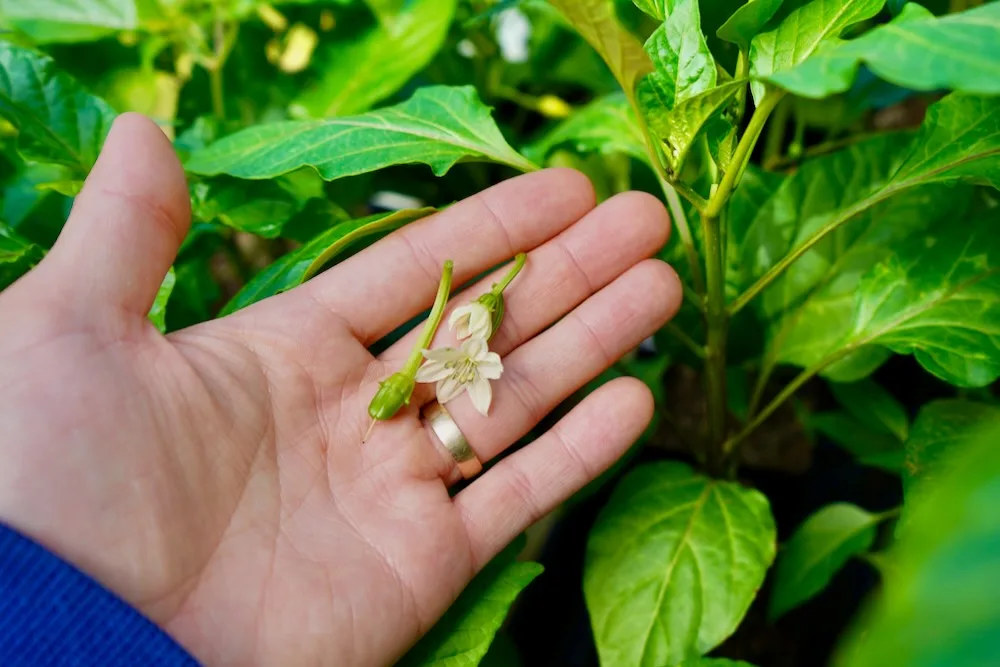
However, there are some cases when we don’t recommend pruning pepper flowers. If you are growing slower-to-produce varieties like ghost peppers or habaneros, you may want to leave early buds to ensure that your peppers ripen.
However, if you are growing faster varieties like jalapeños or bell peppers, early flowers can be pinched back until the plants reach a more mature size.
Timing is everything! Early flowers are a sign that your plants need to be up-potted. If you planted your seeds too early, it is very common to have pre-mature flowers when plants outgrow small containers.
If your plants have been properly transplanted to larger pots at the right time, the leafy growth will continue to expand. Pepper plants will hold off on producing flowers until the plant has reached a mature size. Be sure to learn how and when to transplant your pepper plants.
Plan ahead by scheduling your seed starting according to your planting zone. There’s nothing worse than planting too early and having root-bound plants eager to get outside! Know when to plant your pepper seeds.
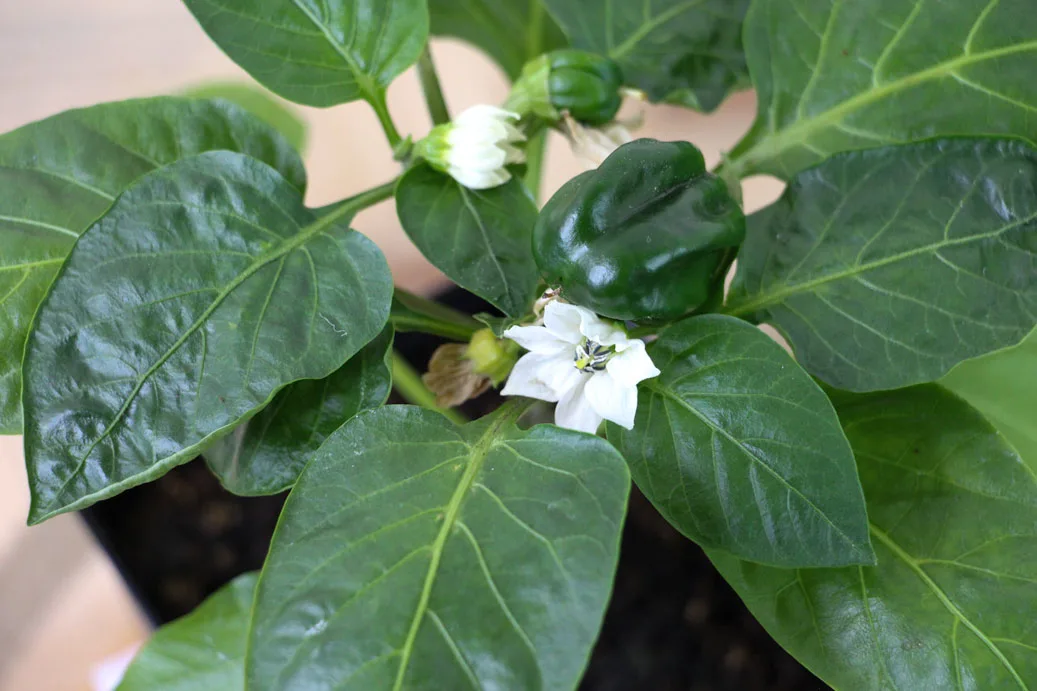
Fertilizing Properly
Using the right fertilizer in early-stage pepper growth can change how many early flower buds your plants produce. During early plant growth, pepper plants prefer a higher percentage of nitrogen.
This helps the plants produce a strong stem, branches, and leaves as opposed to flowers and fruits. If your fertilizer is low in nitrogen, consider switching to something with a higher volume.
For early stage growth, we recommend using one of these fertilizers for pepper plants:
- Fox Farm Grow Big – Part of a 3-pack fertilizer regimen.
- Miracle-Gro Organics
After your plants have reached maturity (usually mid to late July in the Northern Hemisphere), you can either reduce the amount of fertilizer or switch to something with less nitrogen to encourage fruiting.
Keep in mind, I mostly use fertilizer for potted plants, while in-ground gardens need less (or even none). If you have a raised bed or an in-ground garden, I highly recommend composting and amending the soil once or twice per year for slow-release, natural nutrients.
How To Pick Pepper Flower Buds
The last thing you want to do is to damage your pepper plants while pruning flowers. You’ll want to work carefully to avoid damaging any leaves while removing the buds. To help you avoid this, here are a few tips for picking early flowers.
- If the buds are tiny, let them grow larger before picking
- Use tweezers or pruning shears for smaller flowers
- If using your fingers, don’t pinch, just pluck in an upward motion
- Consider waiting for flowers to begin forming a fruit before picking (many will naturally fall off before fruiting)
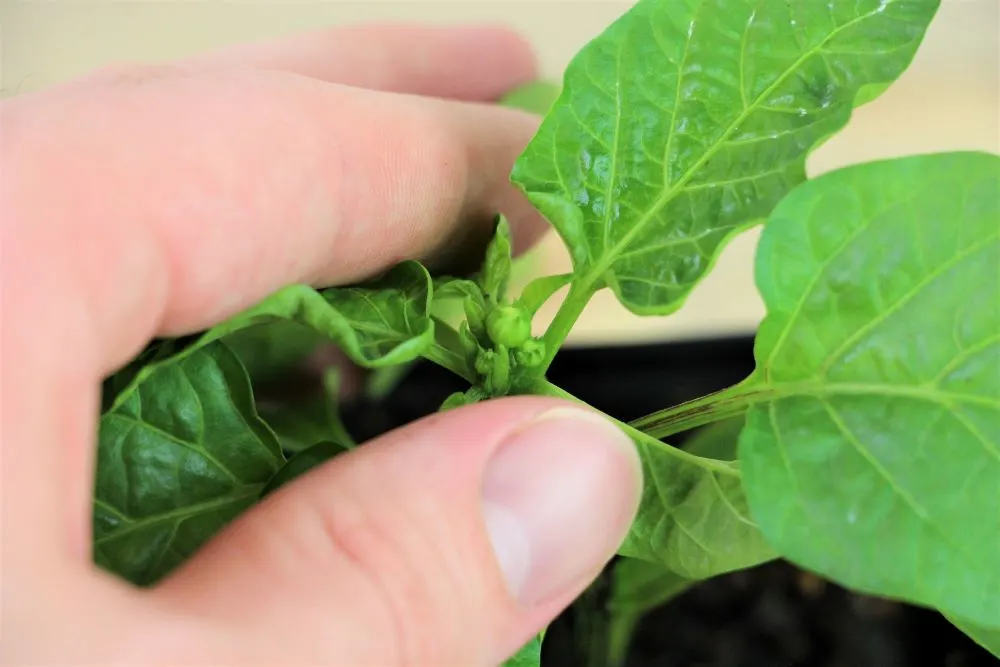
Pepper plant flowers tend to grow in tight bunches right around newly developing leafy growth. Each flower is usually surrounded by new leaves. If the flowers are tiny, it is best to leave them until they are easier to pick to avoid damage.
I find that using tweezers helps get a more precise pluck, especially with peppers that have a smaller flower size. With larger flower buds, it is safe to just use your fingers and pull the flower off in an upward motion.
Tip: It can be painful to remove your plant’s progress, but don’t worry! Healthy pepper plants will produce plenty more flowers later on.
If you have any tiny peppers growing too early in the season, pick those off too! When fruits are growing, the plant is focusing all of its energy on growing the fruits and seeds rather than leaves and branches. Failing to remove early peppers is a main cause of stunted pepper plants.
When To Stop Picking Pepper Flowers
At some point, you have to stop picking your pepper plant’s flowers. After all, the flowers are what grow into the peppers, so when should you stop removing them?
In general, stop picking pepper flowers when your plants have been in their final planting location for 3-4 weeks. This allows the plants enough time to grow a healthy root system and form strong branches and leafy growth. In the Northern hemisphere, we stop pruning flowers around early to mid June (Zone 6).
After 3-4 weeks of being in their final location, the pepper plants should be maturing to a healthy size. The plants will then be ready to set fruit and begin producing peppers. Give your plants enough time to produce fully ripened peppers by the end of the season!
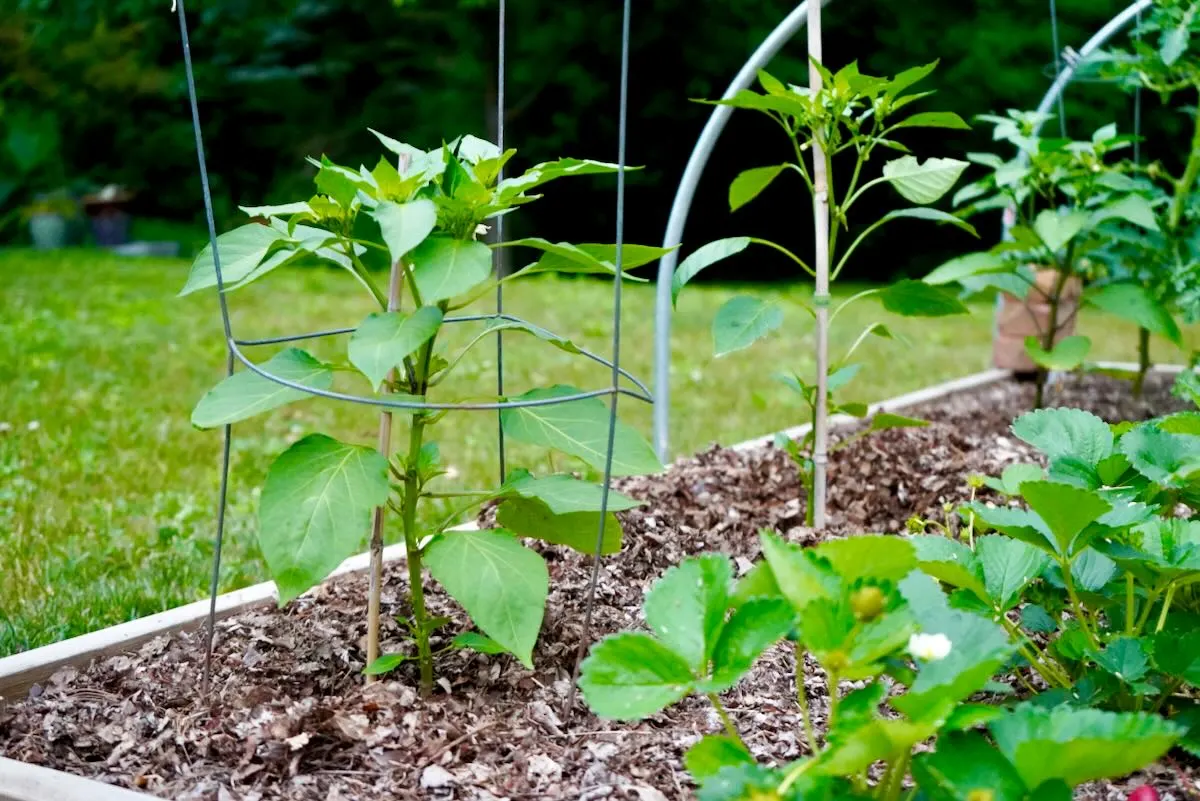
One potential exception is if you live in an especially cold climate. For you far-Northerners, you may want to allow flowers and fruits to form earlier to allow your fruits to ripen before your fall frost date. Pay attention to the ripening time of your pepper variety, and your location’s first frost date.
Note: Nutrients can help encourage your plants to form more flowers and fruits instead of more leaves and branches. Switching to a lower-nitrogen fertilizer halfway through the year is key!
Why Are My Pepper Flowers Falling Off?
During late-stage growth, you want your pepper plants to have lots of flower buds. The more flowers, the more potential peppers. So why are your pepper flowers dropping off instead of growing into peppers?
There are a few possible reasons this could be happening. Let’s go through the possibilities. Learn more about pepper flowers dropping here.
Hot or Cold Temperatures
Peppers like warm weather during the day. This means daytime temps around 75-80°F and night-time temps above 60°F. Having temperatures above or below these can cause stress for the plants.
Excessively hot temperatures in mid-summer is a common cause for flower buds dropping. If you expect a heat-wave with temps above 100°F, try to provide shade through this period and feed the plants plenty of water. This will help avoid too many dropped flower buds.
If you are expecting cold weather below 55°F, consider bringing your potted pepper plants indoors for the night. If you have plants in the ground, you can temporarily cover them with floating row cover for some temporary protection.
Over-fertilizing
After your plants produce flower buds, it is time to change up your fertilizing regimen. I switch from a high nitrogen fertilizer to a lower nitrogen blend. If you continue to use a fertilizer high in nitrogen, your plant may continue to expand and produce more leaves rather than buds.
After I start to see lots of flower buds on our mature plants, it can help to switch to a lower-nitrogen fertilizer like Fox Farm’s Big Bloom. The 3-stage regimen keeps things simple for fertilizing potted peppers with confidence.
Alternatively, you can reduce the strength or frequency of your fertilizing regimen. Some pepper growers even stop fertilizing all together in early August, allowing the plants to use the remaining nutrients in the soil to finish producing.
Over-watering
If you’ve read our article on watering pepper plants, you’ll know that over-watering is one of the most common mistakes newer gardeners make when growing peppers. It is easy to over-care for your peppers, and providing too much water is not good.
Pepper plants are happier when slightly dry as opposed to soaking wet. They need to have moist roots, but they also require good drainage. That is why growing in pots is a good option, especially for first-time pepper growers.
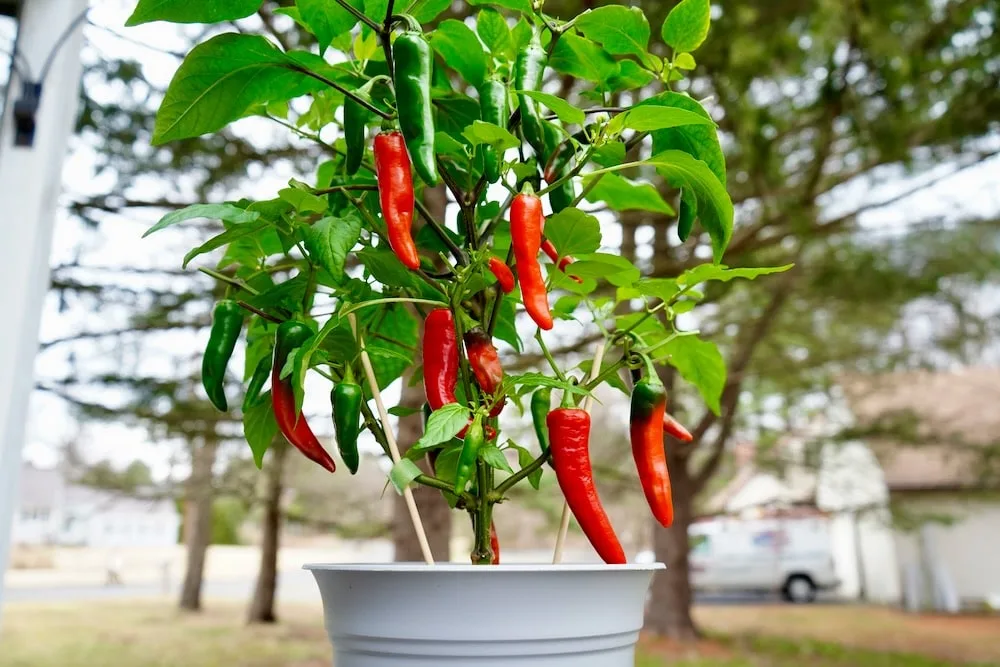
Whether you have pepper plants in pots or in a garden bed, make sure that water can escape from the root system of your plants. Too much water can suffocate the roots and cause yellowing leaves, leaves and flowers dropping off, and even root death.
There could be other reasons for dropping flower buds (poor pollination, disease, etc.), but these are the most likely culprits.
Read Next:
I hope this guide helps you decide when to pluck your early pepper flowers. This simple technique in early spring can help you get the best results from your plants in the long run!


Lisa
Thursday 11th of April 2024
This is great advice about the early flowering that I have experienced for many years on my seedlings. I could never quite understand how to prune off the tiny buds so I would leave them on. Now I know to wait until they are bigger. And I will start using a high nitrogen fertilizer to encourage stronger stems and leaf growth. I appreciate your attention to detail on this post. Thank you!
Gary
Tuesday 19th of March 2024
I have a jalapeno plant that is starting it's 2nd year . Should I remove the buds like I would do on a young plant ?
Gary
Tuesday 19th of March 2024
@peppergeek, Thanks, I pruned it down in the fall . Using the same 15 gal fiber bag from last season . Put it under my grow light 6 weeks ago . New growth is about what I would see from a 2 to 3 month old new plant .
peppergeek
Tuesday 19th of March 2024
It's up to you! I'd start by getting it into the right sized pot. If it's already there, try to encourage it to grow big before setting flowers
Roger Van Hilst
Sunday 10th of September 2023
Great content! Here in Australia. I have overwintered a first year long hot cayenne plant. It has started to shoot from the bare stems in the last couple of weeks (but still short of 1/4 inch in length, but it is already producing flower buds at these points before there is virtually any foliage. It did the same as a seedling last year. It seems all it wants to do is put its energy into flowers and not on leaves first. What do u do here please??
peppergeek
Monday 18th of December 2023
I would probably add nitrogen fertilizer and prune flowers to encourage root growth and foliage growth. One the plant starts growing in size, then you can allow it to start flowering and fruiting
Anthony Stauffacher
Sunday 23rd of July 2023
My Habañero plants are doing great I’m looking at a very promising harvest this year between 3 plants I’ve got about 200 peppers on plant at various sizes! And the plants are all still loaded with flowers trying to produce even more! My question is should I start pinching the new flowers they keep producing so they put energy towards growing and ripening what is already on plant vs trying to produce more? Or does that not really matter? I live in the north zone 4 so I only have another month or two of real warm weather before the cool fall season starts. That is why I’m concerned I don’t know if all of what I have will ripen before it gets too cold. Let me know what you think.
Anthony Stauffacher
Monday 24th of July 2023
@peppergeek, Thanks for your input on that. I’ll just let them go and see what happens. I have them in large pots I plan to try and overwinter my best plant in the house this year and see what I can get out of it next summer. This thing has grown like crazy in its first season from a seedling, it’s now about 18 inches tall and has a canopy at 34 inches across.
peppergeek
Monday 24th of July 2023
That's an amazing harvest! Once the plants get producing, we don't pinch anymore flowers. Removing some really small fruits can help ripen up the bigger ones, but not much faster in our experience. They will drop any that the plant can't support naturally, and as you harvest, the plant will direct more resources towards more fruits! Great work, good luck.
Landon
Friday 21st of July 2023
Help! I have 2 chiltepin pepper plants that I started from seed. After over a year, they've finally started bearing fruit. They got pretty tall, and not bushy due to my reluctance in pruning them. I did find that they were getting a spider mite infestation and tried controlling them with insecticide "A". After a while, the problem got worse, and the infestation grew. I used neem oil, and repotted them with new soil, keeping some of the old soil as well to prevent shock. I think the infestation is under control now, but I fear pruning more than ever because the branches lost a ton of leaves near the stems, and they continue to lose leaves if shaken. Is there any hope for my plants?